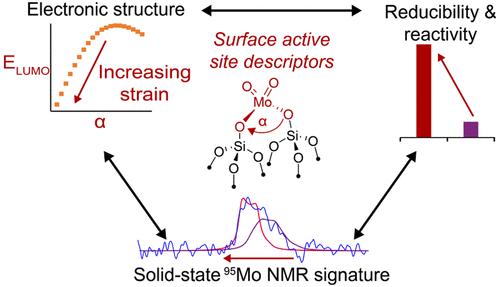当前位置:
X-MOL 学术
›
J. Am. Chem. Soc.
›
论文详情
Our official English website, www.x-mol.net, welcomes your feedback! (Note: you will need to create a separate account there.)
Active Site Descriptors from 95Mo NMR Signatures of Silica-Supported Mo-Based Olefin Metathesis Catalysts
Journal of the American Chemical Society ( IF 15.0 ) Pub Date : 2023-05-31 , DOI: 10.1021/jacs.3c02201 Zachariah J Berkson 1 , Ran Zhu 2 , Christian Ehinger 1 , Lukas Lätsch 1 , Stefan P Schmid 1 , Darryl Nater 1 , Stephan Pollitt 1, 3 , Olga V Safonova 3 , Snædís Björgvinsdóttir 1 , Alexander B Barnes 1 , Yuriy Román-Leshkov 2 , Gregory A Price 4 , Glenn J Sunley 4 , Christophe Copéret 1
Journal of the American Chemical Society ( IF 15.0 ) Pub Date : 2023-05-31 , DOI: 10.1021/jacs.3c02201 Zachariah J Berkson 1 , Ran Zhu 2 , Christian Ehinger 1 , Lukas Lätsch 1 , Stefan P Schmid 1 , Darryl Nater 1 , Stephan Pollitt 1, 3 , Olga V Safonova 3 , Snædís Björgvinsdóttir 1 , Alexander B Barnes 1 , Yuriy Román-Leshkov 2 , Gregory A Price 4 , Glenn J Sunley 4 , Christophe Copéret 1
Affiliation

|
The olefin metathesis activity of silica-supported molybdenum oxides depends strongly on metal loading and preparation conditions, indicating that the nature and/or amounts of the active sites vary across compositionally similar catalysts. This is illustrated by comparing Mo-based (pre)catalysts prepared by impregnation (2.5–15.6 wt % Mo) and a model material (2.3 wt % Mo) synthesized via surface organometallic chemistry (SOMC). Analyses of FTIR, UV–vis, and Mo K-edge X-ray absorption spectra show that these (pre)catalysts are composed predominantly of similar isolated Mo dioxo sites. However, they exhibit different reaction properties in both liquid and gas-phase olefin metathesis with the SOMC-derived catalyst outperforming a classical catalyst of a similar Mo loading by ×1.5–2.0. Notably, solid-state 95Mo NMR analyses leveraging state-of-the-art high-field (28.2 T) measurement conditions resolve four distinct surface Mo dioxo sites with distributions that depend on the (pre)catalyst preparation methods. The intensity of a specific deshielded 95Mo NMR signal, which is most prominent in the SOMC-derived catalyst, is linked to reducibility and catalytic activity. First-principles calculations show that 95Mo NMR parameters directly manifest the local strain and coordination environment: acute (SiO–Mo(O)2–OSi) angles and low coordination numbers at Mo lead to highly deshielded 95Mo chemical shifts and small quadrupolar coupling constants, respectively. Natural chemical shift analyses relate the 95Mo NMR signature of strained species to low LUMO energies, which is consistent with their high reducibility and corresponding reactivity. The 95Mo chemical shifts of supported Mo dioxo sites are thus linked to their specific electronic structures, providing a powerful descriptor for their propensity toward reduction and formation of active sites.
中文翻译:

二氧化硅负载的钼基烯烃复分解催化剂的 95Mo NMR 特征的活性位点描述符
二氧化硅负载的氧化钼的烯烃复分解活性在很大程度上取决于金属载量和制备条件,这表明活性位点的性质和/或数量在组成相似的催化剂中有所不同。这通过比较通过浸渍制备的钼基(预)催化剂(2.5-15.6 wt% Mo)和通过表面有机金属化学(SOMC)合成的模型材料(2.3 wt% Mo)来说明。对 FTIR、UV-vis 和 Mo K-edge X 射线吸收光谱的分析表明,这些(预)催化剂主要由类似的孤立的 Mo 二氧代位点组成。然而,它们在液相和气相烯烃复分解反应中表现出不同的反应特性,SOMC 衍生的催化剂比具有类似 Mo 负载量的经典催化剂高出 1.5-2.0 倍。值得注意的是,固态95Mo NMR 分析利用最先进的高场 (28.2 T) 测量条件解析了四个不同的表面 Mo 二氧代位点,其分布取决于(预)催化剂制备方法。在 SOMC 衍生的催化剂中最突出的特定去屏蔽95 Mo NMR 信号的强度与还原性和催化活性有关。第一性原理计算表明,95 Mo NMR 参数直接体现局部应变和配位环境:Mo 处的锐角 (SiO–Mo(O) 2 –OSi) 和低配位数导致高度去屏蔽的95 Mo 化学位移和小的四极耦合常数,分别。自然化学位移分析涉及95应变物种的 Mo NMR 特征为低 LUMO 能量,这与其高还原性和相应的反应性一致。因此,支持的 Mo 二氧代位点的95 Mo 化学位移与其特定的电子结构相关联,为它们倾向于还原和形成活性位点提供了强有力的描述符。
更新日期:2023-05-31
中文翻译:

二氧化硅负载的钼基烯烃复分解催化剂的 95Mo NMR 特征的活性位点描述符
二氧化硅负载的氧化钼的烯烃复分解活性在很大程度上取决于金属载量和制备条件,这表明活性位点的性质和/或数量在组成相似的催化剂中有所不同。这通过比较通过浸渍制备的钼基(预)催化剂(2.5-15.6 wt% Mo)和通过表面有机金属化学(SOMC)合成的模型材料(2.3 wt% Mo)来说明。对 FTIR、UV-vis 和 Mo K-edge X 射线吸收光谱的分析表明,这些(预)催化剂主要由类似的孤立的 Mo 二氧代位点组成。然而,它们在液相和气相烯烃复分解反应中表现出不同的反应特性,SOMC 衍生的催化剂比具有类似 Mo 负载量的经典催化剂高出 1.5-2.0 倍。值得注意的是,固态95Mo NMR 分析利用最先进的高场 (28.2 T) 测量条件解析了四个不同的表面 Mo 二氧代位点,其分布取决于(预)催化剂制备方法。在 SOMC 衍生的催化剂中最突出的特定去屏蔽95 Mo NMR 信号的强度与还原性和催化活性有关。第一性原理计算表明,95 Mo NMR 参数直接体现局部应变和配位环境:Mo 处的锐角 (SiO–Mo(O) 2 –OSi) 和低配位数导致高度去屏蔽的95 Mo 化学位移和小的四极耦合常数,分别。自然化学位移分析涉及95应变物种的 Mo NMR 特征为低 LUMO 能量,这与其高还原性和相应的反应性一致。因此,支持的 Mo 二氧代位点的95 Mo 化学位移与其特定的电子结构相关联,为它们倾向于还原和形成活性位点提供了强有力的描述符。


























 京公网安备 11010802027423号
京公网安备 11010802027423号